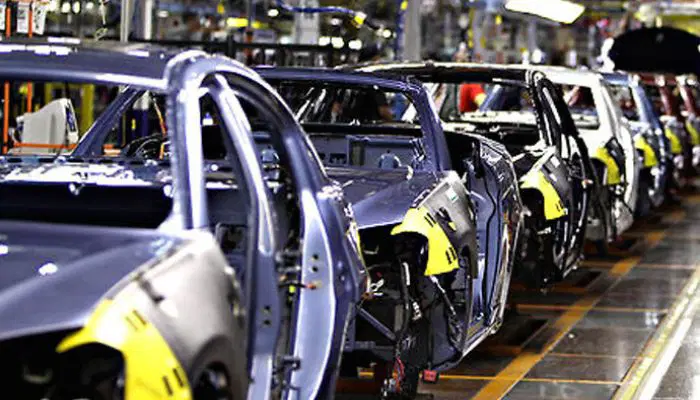Tech
Tech war: China sees glut of AI data centres as GPU mismatches exacerbate weak demand
Published
6 months agoon
By
Ekwutos BlogTotal computing power in China accounted for 26 per cent of the world’s total as of June, trailing only the US, but CPU usage rates are low
China’s rush to build a nationwide network of artificial intelligence (AI) data centres is running the risk of creating an oversupply of computing power, experts and industry professionals said.
Data from CCID Consulting, a government-backed think tank focused on technology, shows that more than 250 internet data centres have either been built or are under construction in China as of June, as local governments, state-owned telecommunications network operators and private investors pour money into the “new infrastructure”.
Many of these artificial intelligence (AI) computing facilities are also located in areas far from the nation’s technology centres.
Do you have questions about the biggest topics and trends from around the world? Get the answers with SCMP Knowledge, our new platform of curated content with explainers, FAQs, analyses and infographics brought to you by our award-winning team.
Total computing power in China reached a whopping 246 Eflops as of June this year, according to data published in September by the China Academy of Information and Communications Technology (CAICT), an institute affiliated with the Ministry of Industry and Information Technology. Eflops is a unit for measuring the speed of a computer system.
That accounted for 26 per cent of the world’s total, trailing only behind the US, according to CAICT.
However, the central processing unit (CPU) use rate of computing resources provided by privately-held servers is less than 5 per cent, according to a research report on the public cloud issued by China’s State Information Centre (SIC), a group affiliated with the National Development and Reform Commission. Experts warn of an impending glut of computing power as many data centres sit idle due to lack of demand.
“In the past few years, with the buildout of new infrastructure, some government-backed companies did build some data centres which now sit idle,” said Helen Fang, head of industrial research at HSBC. “These centres tend to not be located in or around first-tier cities, or are too small in size to meet mainstream demand.”
China’s provincial governments are rushing to support new data centres to spur the local economy, according to an employee of a mainland AI chip start-up, who declined to be named. There is little consideration given to how the data centre could operate after it is built, the person added.
Shan Zhiguang, a director at the State Information Centre, warned in April that many jurisdictions in the country are rushing to build data centres, based on the suppliers’ sales agenda instead of market demand. “The demand for computing power in China is still limited due to the lack of big models-based killer applications,” Shan said. “If built too early and too much, it may create a glut,” he told Chinese media 21st Century Business Herald.
Amid US sanctions that restrict Chinese enterprises from buying advanced chips from suppliers like Nvidia, many of these government-backed projects were given tacit orders to prioritise the use of domestic CPUs, graphics processing units (GPUs) and memory chips over foreign counterparts. That would only aggravate the situation because domestic-made hardware from various brands is more difficult to configure, especially if connected to form large computing clusters consisting more than 10,000 GPUs, according to experts.

Visitors learn about cloud computing at Alibaba’s APSARA Conference 2024, Sept. 19, 2024. Photo: Xinhua
In one example, China Mobile’s newest data centre is in Harbin, capital of northeast Heilongjiang province, and runs on 18,000 domestic-made GPUs. Separately, Jixi, a traditional coal-mining city in the province, inked a deal in May with a Hainan construction company to invest 14 billion yuan (US$1.98 billion) to build a data centre using only Chinese suppliers, including Tencent Cloud, AI chip start-up EnFlame, and Chinese chip giant Sugon.
Government-built data centres are often required to use domestic hardware and software together, according to a former manager of SenseTime who works on generative AI-related projects. Domestic GPUs are only compatible with certain models, this person said. So if a company wants to train or use foreign models it has to use Nvidia cards, not government-owned computing resources, the person added.
More Articles from SCMP
Xpeng bets on Eagle Eye technology to enhance autonomous driving in new P7+ sedan
Better ways for US to win hearts and minds
Was doomed US submarine caught by a monster whirlpool in the South China Sea?
China’s stimulus measures just first step on economic reform journey
This article originally appeared on the South China Morning Post (www.scmp.com), the leading news media reporting on China and Asia.
You may like


Charitable acts attract divine reward- President Obasanjo


Rivers Emergency Rule: NBA took illegal gift from Fubara – Wike


IMO GOVERNMENT DISOWNS FRAUDULENT SIENNA LEVIES, ORDERS CRACKDOWN ON EXTORTIONISTS


PRESIDENT TINUBU’S EASTER MESSAGE TO THE NATION


APC more divided than PDP – Damagum declares as he receives defectors


Six IMSU Law Graduates Bag First Class at the Nigerian Law School
Tech
Gov Soludo is a greater supporter of Innoson group but our Office in Anambra was demolished without pre-notification from government— Innoson Group
Published
5 hours agoon
April 18, 2025By
Ekwutos Blog
Innoson Vehicle Manufacturing (IVM) has expressed displeasure over the partial demolition of its Head Office, situated on the Owerri-Nnewi road.
Mr Cornel Osigwe, Head of Corporate Communications at Innoson Group, who confirmed the demolition to newsmen, said that there was no pre notification ahead of the demolition which took place on Wednesday.
He claimed that the office perimeter fence, some offices, stair case and the company’s showroom were affected by the partial demolition.
According to him, there was no pre notification ahead of the demolition; it came to us as a surprise.
“We did not know that the building itself was marked for demolition and if it was marked, they should have given us time to relocate.
“The staff were working and they just saw the demolition vehicle demolishing the building while work was going on.
“Some of our staff were trapped in the building, it took the efforts of our other staff to rescue those that were trapped while over 20 vehicles were also trapped.
“A day before the demolition, there was an announcement that there was going to be a demolition and they were going to give one week for the houses that were marked for demolition to relocate.
“The company was not aware that the company was marked for demolition, and even if it was aware.
“There have been a public announcement that all the marked buildings have one week to relocate, but all those things were not considered
“There were other buildings that were close to the head office and marked for demolition were not demolished but they came straight to our building and demolished it, making us to wonder if there was another ulterior motive to it,” he said.
“Gov. Charles Soludo of Anambra has been a great supporter of Innoson Vehicle and Innoson has been a great supporter of the state government.

“But the way and manner that everything happened makes us to wonder if the state government is aware that those handling the demolition have personal vendetta against the company,” he added.
Tech
They only know how to drain data’ – Telecom consumers lament tariff hike, poor network
Published
4 days agoon
April 14, 2025By
Ekwutos Blog
Some telecommunication services consumers in the Federal Capital Territory, FCT have urged Mobile Network Operators to improve their services to match the recent hike in their tariffs.
They made the call in separate interviews with NAN on Monday in Abuja.
The subscribers said despite the increase in subscription rates mobile networks could remain epileptic for hours.
In a publication dated February 6, 2024, the Executive Vice-chairman of the Nigerian Communications Commission, Dr Aminu Maida, said that the commission would hold service providers accountable for poor service delivery.
Mr Ogah Paul, one of the subscribers said he had enough data on his network but could not access the internet because of the epileptic network.
He urged service providers to fix the problems surrounding the poor services.
“The only thing they know is to drain data without any good service delivery. I feel like crying because of a problematic network. I have been receiving server errors since morning.
“To even download and watch a video sent to me since, takes me almost one whole day. “I wonder if members of staff of the service providers are enjoying the service they render to us.
“We cannot make calls, access the internet or even receive calls,’’ he said.
According to him, unfortunately, the network providers put up some of the best adverts about their products and services which they cannot meet.
Mr Victor James, another subscriber said he had enough data but was not able to use it to his satisfaction.
“Why does their data plan not reflect immediately when you buy data? Sometimes it takes as much as 24 hours to reflect.
“I am tired of this. The network is really bad. I have enough data but I cannot use it the way I want.
“I hope the issues get resolved as soon as possible so that I can access my data without further delay,” he said.
However, Ms Josephine Tanko, told NAN that she had no problems with her network providers.
“It is fast and reliable. I think it is the network that gives the best internet speed and quality.
“It will always be my best that is why I will always choose it over any other network,” she said.
She called on networks that did not meet their subscriber’s expectations to ensure that they improved their services.

By Adegboyega Adeleye
The importance of cars in transportation cannot be overemphasised with some countries known for their production.
Transportation is required for work, school, and industry, with car production fast becoming a major producer of revenue and a player in the global was financial market.
Car production is one of the largest economic sectors internationally; however, some countries produce more cars than others. The list of countries by motor vehicle production is based on statistics by the International Organization of Motor Vehicle Manufacturers.
The world’s car manufacturers put another 93.5 million vehicles on the roads in 2023, the last full-year numbers currently available.
This article will explore the top 5 countries with the highest car production.
1. China
China, the world’s biggest manufacturer overall, leads the world in car production. The country’s 2023 production totaled more than 30 million vehicles, adding up to more than 30% of all cars and trucks produced globally.
The largest domestic car manufacturers in China, known as the traditional “Big Four,” are SAIC Motor, Dongfeng, FAW, and Chang’an.
2. United States
The United States–a major automotive producer, known for its large vehicle market–is the second biggest auto manufacturing country with a volume of 10,611,555. This represents about 5.5 percent growth compared to the 10,060,339 produced in 2022.
The United States produces less than half of what China does, having manufactured about 1.8 million cars and 8.3 million commercial vehicles in 2022. The United States’ largest car manufacturers, referred to as the “Big Three,” are General Motors, Ford Motor Company, and Fiat Chrysler.
3. Japan
Japan ranked as the third biggest automobile-producing country in the world with a total volume of 8,997,440 vehicles manufactured in 2023. The country is a significant player in the global automotive industry, known for its engineering and quality.
After a sudden drop in production from 2020-2022 due to the COVID-19 pandemic, Japan produced just under 9 million vehicles in 2023 (8,997,440)–a drop from its pre-COVID total of nearly 9.7 million in 2019.
However, the volume grew by 14.8 percent compared to the 7,835,519 produced in 2022.
Japan’s automotive industry is one of the largest industries in the world. The country’s automotive manufacturers include Toyota, Honda, Daihatsu, Nissan, Suzuki, Mazda, Mitsubishi, Subaru, Isuzu, etc.
4. India
India is the fourth-largest automobile-producing country in the world with a total number of 5,851,507 manufactured in 2023. The volume of vehicles grew by 7.2 percent compared to 5,456,857 vehicles produced in 2022.
Although, India is not renowned in America or Europe as a vehicle manufacturer, the Asian nation produced 5.8 million cars in 2023– an annual increase of 7%. India’s export markets for vehicles include Saudi Arabia, South Africa, and Mexico.
The nation is rapidly growing as an automotive market and producer.
5. South Korea
South Korea is the fifth-largest auto-producing country in the world. The country manufactured a total of 4,244,000 vehicles in 2023, representing a growth of 13 percent from a total of 3,757,049 vehicles produced in 2022.
The major South Korean automobile manufacturers include GM Korea, Hyundai Motor Group and its affiliate, Kia Corporation along with Renault Korea Motors.

Charitable acts attract divine reward- President Obasanjo

Rivers Emergency Rule: NBA took illegal gift from Fubara – Wike

IMO GOVERNMENT DISOWNS FRAUDULENT SIENNA LEVIES, ORDERS CRACKDOWN ON EXTORTIONISTS
Trending

 Trending6 months ago
Trending6 months agoNYA demands release of ‘abducted’ Imo chairman, preaches good governance
- Business6 months ago
US court acquits Air Peace boss, slams Mayfield $4000 fine

 Politics6 months ago
Politics6 months agoMexico’s new president causes concern just weeks before the US elections
- Entertainment6 months ago
Bobrisky transferred from Immigration to FCID, spends night behind bars
- Entertainment6 months ago
Bobrisky falls ill in police custody, rushed to hospital

 Politics6 months ago
Politics6 months agoRussia bans imports of agro-products from Kazakhstan after refusal to join BRICS

 Politics6 months ago
Politics6 months agoPutin invites 20 world leaders
- Politics1 year ago
Nigerian Senate passes Bill seeking the establishment of the South East Development Commission.

